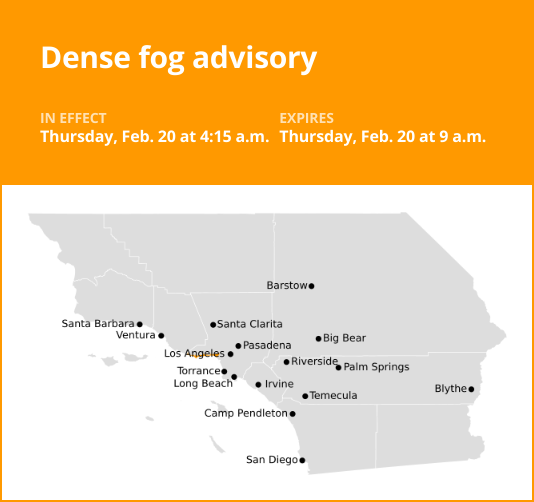The National Weather Service issued an updated dense fog advisory at 4:15 a.m. on Thursday in effect until 9 a.m. for Malibu.
The NWS Los Angeles/Oxnard CA said, “Visibility one quarter to one half mile in dense fog.”
“Gusty winds will blow around unsecured objects. Tree limbs could be blown down and a few power outages may result. Low visibility could make driving conditions hazardous,” the NWS said. “Winds this strong can make driving difficult, especially for high profile vehicles. Use extra caution. If driving, slow down, use your headlights, and leave plenty of distance ahead of you.”

Guidance from the NWS for navigating foggy conditions
If a dense fog advisory is issued for your area, it means that widespread dense fog has developed and visibility often drops to just a quarter-mile or less. These conditions can make driving challenging, so exercise extreme caution on the road, and if possible, consider delaying your trip.
If you must venture out in foggy conditions, keep these safety tips from the NWS in mind:
Moderate your speed:
Slow down and allow extra travel time to reach your destination safely.
Visibility matters:
Ensure your vehicle is visible to others by using low-beam headlights, which automatically activate your taillights. Utilize fog lights if your vehicle is equipped with them.
Avoid high-beams:
Refrain from using high-beam headlights, as they create glare that impairs your visibility on the road.
Keep a safe distance:
Leave a safe distance between you and the vehicle in front of you to account for sudden stops or changes in the traffic pattern.
Stay in your lane:
To ensure you are staying in the correct lane, use the road’s lane markings as a guide.
Zero visibility protocol:
In cases of near-zero visibility due to dense fog, activate your hazard lights and seek a safe spot, like a nearby business parking lot, to pull over and stop.
Limited parking options:
If no designated parking area is available, pull your vehicle as far off the road as possible. Once stationary, deactivate all lights except the hazard flashers, engage the emergency brake, and release the brake pedal to ensure your tail lights remain unlit, minimizing the chance of other drivers colliding with your stationary vehicle.
By adhering to these recommendations from the NWS, you can navigate foggy conditions with greater safety, mitigating the risk of accidents and prioritizing your well-being.